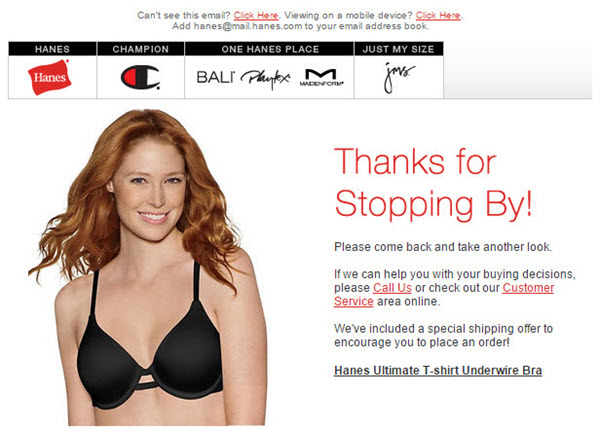Note from Jeanne: Happy Throwback Thursday! I continue to work with clients to make their marketing more personalized — without crossing into the creepy zone. A discussion I had last week in a meeting reminded me of this article from June of last year (it was originally published as part of my ClickZ Email Marketing Column) — read on for some tips on using personalization in a way that won’t upset your customers.
Last week I had the pleasure of speaking at the Specialized Information Publishers Association’s (SIPA, a division of SIIA) Annual Conference. My presentation focused on data, technology and testing in digital marketing and a particularly interesting discussion arose around browse reminders.
Were they good marketing tools or creepy?
The trigger was this browse reminder email, which I received from Hanes.com:
I was using this as an example of customization – the product featured is one I had looked at but had not put in my cart. I had looked at a few items but had left without putting anything in my cart.
One attendee raised her hand and said she was creeped out by this. The idea that Hanes knew what I looked at on their Website, even though I didn’t put anything in my cart – she understood that. She knew how cookies and click-stream tracking worked. But the idea that they would use that information to email me – that was unsettling to her. She said it reminded her of when she looked at a pair of shoes online – and then those shoes stalked her around the Internet, showing up in ads at every other site she visited.
On the one hand, understandable. It’s a new phenomenon to have possessions we considered purchasing follow us around. On the other hand, understandable; in the industry it’s called remarketing. And it’s something more and more retailers are doing to drive sales. They’re doing it because it’s profitable.
So how do we balance the need to drive sales with the need not to appear ‘creepy’ to at least some of our customers?
I recall a time, years ago, that I got an email from someone touting a new technology that might be useful to my clients. He said he could track in real time a person’s movements around my clients’ websites. I was intrigued and clicked through to his website to learn more.
I was about three pages into my exploration when the phone rang. I answered. The sender of the email introduced himself and then asked what I thought about the three pages – he could reference their content specifically – of their website that I had viewed.
Just like the person in my session today, I was creeped out. I ended the conversation as quickly as possible and never did recommend this technology to my clients.
But perhaps that gentleman was just ahead of his time. And perhaps my cringing was a sign of being unwilling to overcome my discomfort and embrace the future. Consumer perceptions of privacy are changing. Things that used to be technologically difficult, if not impossible, are now common place.
Think about cart abandonment. If you’re shopping in a brick-and-mortar store and you decide to leave and abandon your cart, no one comes after you. Chances are no one knows it was you. But if you do that online today ecommerce marketers would be remiss if they didn’t sent you at least one cart abandonment email. And the most sophisticated companies will send you multiple reminders, including images of the items in your card, to entice you to come back and purchase. They might even offer you a discount.
And most consumers would not be put off by this. Many online retailers are more concerned with consumers gaming the system to get the discount than they are with people being creeped out.
So where do we, as marketers, draw the line?
Do we use all the technology available to us to drive a sale – or do we hold back to avoid creeping out potential customers? It’s a fine balance.
My set presentation took a back seat as we hashed out this issue. In this end this is where we landed:
- Sending cart abandonment emails was okay, as the action of putting something in your cart created the expectation that the retailer would know about it.
- Sending browse reminder emails referencing that you had visited the site without putting something in your cart was over the line – whether or not they included an image of what you had viewed.
- But sending a general email which did not reference the fact that you had visited the site but that did include an image of something you had viewed on the site was deemed acceptable.
Bottom line: every marketer needs to determine what is best for their own organization – and for their own customers. This is a business decision. What is the cost of the ‘creepiness’ factor? Does it outweigh the additional revenue generated, both in the short and the long term?
Adding another level of complexity: consumer sentiment on ‘creepiness’ is evolving. As more companies adopt abandon cart and browse remarketing it becomes more prevalent. And as it becomes more prevalent it becomes more expected, more accepted and less creepy.
Where is your audience on the spectrum? Once you find out, you can work out how transparent you can be about targeting them based on observed behaviors without becoming ‘creepy.’







